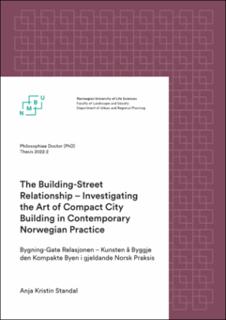| dc.contributor.advisor | Børrud, Elin | |
| dc.contributor.advisor | Holth, Fredrik | |
| dc.contributor.author | Standal, Anja Kristin | |
| dc.coverage.spatial | Norway | en_US |
| dc.date.accessioned | 2022-04-29T12:38:28Z | |
| dc.date.available | 2022-04-29T12:38:28Z | |
| dc.date.issued | 2022 | |
| dc.identifier.isbn | 978-82-575-1878-3 | |
| dc.identifier.issn | 1894-6402 | |
| dc.identifier.uri | https://hdl.handle.net/11250/2993436 | |
| dc.description.abstract | Cities comprise constantly changing elements and patterns of human interventions. Patterns which we experience, evaluate, and continuously develop through an ever, ongoing range of decisions. This thesis asks questions about how we can build the city in a way that responds to our urban experiences by operationalising this experience into knowledge as a basis for city building, the thesis delves into the details of what we perceive as urban – the relationships between buildings and cityscape, between private and public, and the unavoidable detailed close relationship between buildings and streets. These micro-morphological details embody the preconditions and dynamics of a living city, manifest through urban form, and the processes and decisions which define it. The title: ‘The Building–Street Relationship: Investigating the Art of Compact City Building in Contemporary Norwegian Practice’, presents the main content and principles addressed throughout the thesis. It engages in the production of urban form; its core focus and units of analysis include the boundary between the physical entities of buildings and streets and how these morphological units interrelate, researched through the field of Urban Morphology. Relationship addresses the link between these two spatial units, but also a main ontological understanding, namely that of investigating urban form as being relational rather than about objects. This indirectly includes the users of space – human beings – and their experiences, behaviour, and decisions as well as their relation to built form and space. By city building, I refer to the implementation of plans, which provide urban quality, while the Art of refers to the professional skills and methods required to address this complexity, as well as to the craft included in the ‘making disciplines’ of city building. Compact city refers to both the sustainability model, which this thesis engages with as a current and actual model for implementation within the Norwegian sustainable urban densification agenda of land use policy, and as ‘built form’ inspired by the traditional city. This is all underpinned by the main field of investigation of the thesis – the field of Urban Morphology. Finally, Contemporary Norwegian Practice addresses the actuality of the thesis, its context of investigation, and the institutional framework and legislation used in implementing its physical results. | en_US |
| dc.description.abstract | Byar er sett saman med ei byform av ei rekkje stadig skiftande mønster, formelement og strukturar, som er danna som eit resultat av tallause menneskelege handlingar og inngrep. Desse mønstra kan vi oppleve, evaluere og kontinuerleg utvikle gjennom ei rekkje avgjerder. Denne oppgåva spør korleis vi kan byggje byen på ein måte som tek omsyn til våre urbane erfaringar og bruke desse erfaringane som grunnlag for kunnskapsutvikling om bybygging. Oppgåva fokuserer på dei mikro-morfologiske detaljane i det som vi oppfattar som urbant; på samanhengen mellom bygning og by, mellom privat og offentleg og dei uløyselege relasjonane mellom bygningar og gater. Desse detaljane legg føresetnader for å skape ein levande kompakt by, og som ein kan undersøke gjennom å studere byens form og prosessane som definerer denne forma.
Tittelen på denne oppgåva, ‘The Building–Street Relationship: Investigating the Art of Compact City Building in Contemporary Norwegian Practice’ presenterer hovudinnhaldet og prinsippa som vert teke opp i avhandlinga. Det overordna problemet for denne avhandlinga inkluderer kompakt bybygging (kva er det) og byutvikling som prosess (korleis ein legg rammer for bybygginga). Studieobjektet og hovudfokuset i avhandlinga er relasjonen mellom bygningar og gater, og korleis desse morfologiske einingane heng saman. Ordet ‘Relationship’ (relasjon) omhandlar koplinga mellom desse to rommelege einingane, samstundes presenterer det oppgåva sitt ontologiske perspektiv, nemleg å utforske byen som ei relasjonell eining heller enn som ei samling av objekt. I tillegg tek ordet omsyn til brukarane av byen, menneska og deira erfaringar, åtferd og avgjerder, samt deira forhold til byform og byrom. Med ‘the Art of City Building’ (Bybygging) viser eg til dei faglege ferdigheitene og metodane som ein treng for å ta omsyn til kompleksiteten med bybygginga, samt handverket ein tek i bruk i dei praktiske fagfelta som er relevante for denne oppgåva. ‘Compact City’ (Kompakt by) viser både til modellen for berekraft som dannar bakteppet for denne oppgåva, til den gjeldande arealpolitikken i Norge og som fysisk byform inspirert av den tradisjonelle byen. Alle desse komponentane er sett frå ein ståstad som dannar hovudfeltet for denne oppgåva, bymorfologi (Urban Morphology). Til slutt viser ordet ‘Contemporary Norwegian Practice’ (gjeldande norsk praksis) til oppgåva sin aktualitet og den konkrete konteksten for undersøkinga, med det institusjonelle rammeverket og lovverket som vert brukt for å implementere bybygginga. | en_US |
| dc.language.iso | eng | en_US |
| dc.publisher | Norwegian University of Life Sciences, Ås | en_US |
| dc.relation.ispartofseries | PhD thesis;2022:2 | |
| dc.rights | Attribution-NonCommercial-NoDerivatives 4.0 Internasjonal | * |
| dc.rights.uri | http://creativecommons.org/licenses/by-nc-nd/4.0/deed.no | * |
| dc.subject | Building-street relationship | en_US |
| dc.subject | Urban morphology | en_US |
| dc.subject | Towns | en_US |
| dc.subject | Urban planning | en_US |
| dc.title | The building-street relationship : investigating the art of compact city building in contemporary Norwegian practice | en_US |
| dc.title.alternative | Bygning-gate relasjonen : kunsten å byggje den kompakte byen i gjeldande norsk praksis | en_US |
| dc.type | Doctoral thesis | en_US |

